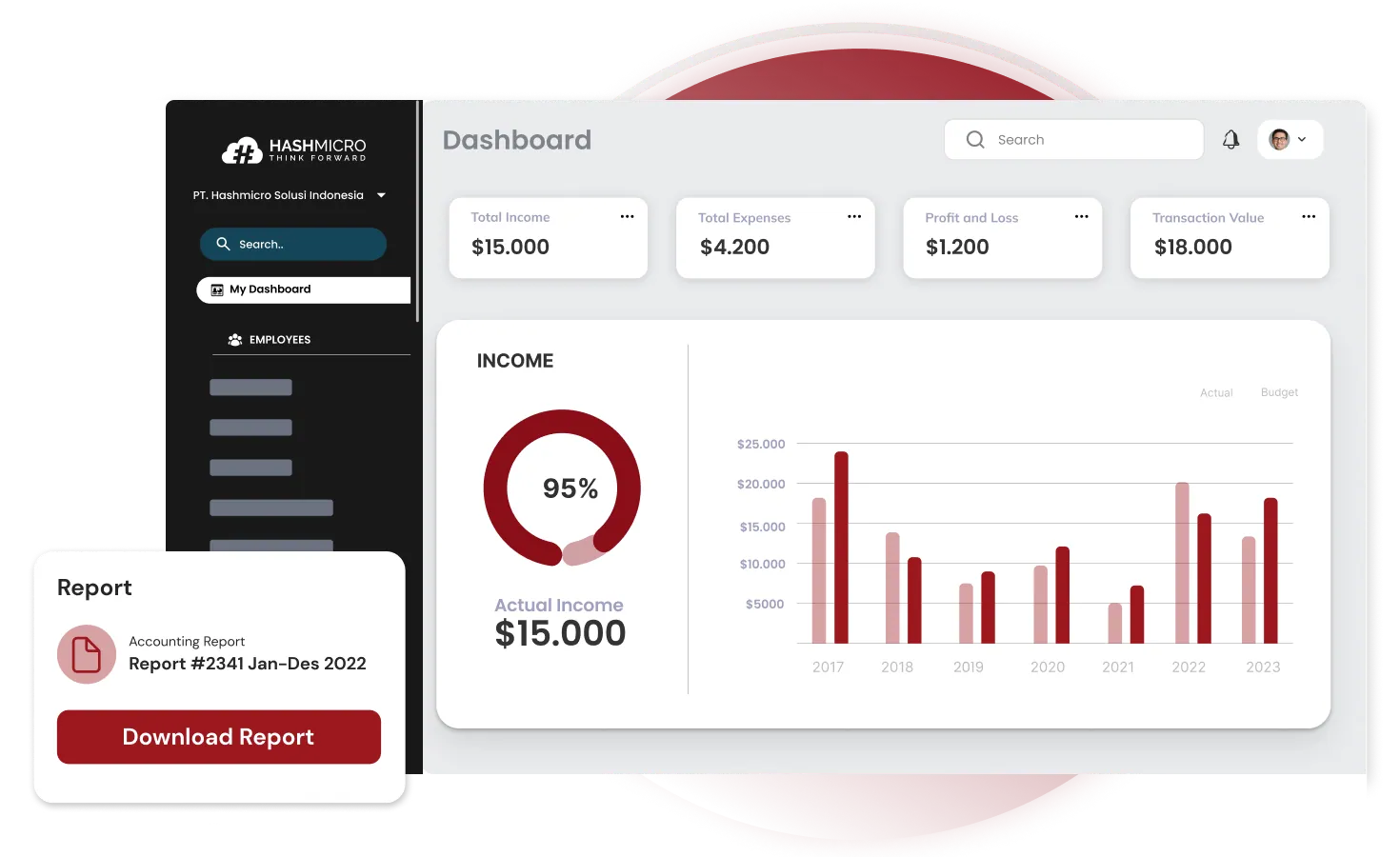Double-entry accounting is the foundation of accurate financial management. It ensures that every transaction is recorded in two accounts to maintain balance. Businesses widely use this system to track assets, liabilities, and equity precisely.
Singapore’s accounting software market is projected to grow at a 4.2% CAGR from 2025 to 2031, driven by the increasing adoption of cloud-based solutions that support double-entry accounting systems for better financial management.
HashMicro Accounting Software simplifies this process with an automated double-entry system that reduces manual errors, improves efficiency, and provides real-time financial insights.
This article will explore the principles, benefits, and working mechanisms of double-entry accounting and its role in improving business financial accuracy and efficiency.
Table of Content:
Table of Content

Key Takeaways
|
What is Double Entry Accounting?
Double-entry accounting is a bookkeeping system that records transactions in two accounts to maintain financial balance. It applies equal debit and credit entries, ensuring accuracy in tracking assets, liabilities, and equity.
Each transaction includes a debit entry in one account and a corresponding credit entry in another, ensuring that total debits always equal total credits. This structured approach helps businesses maintain accurate financial records, reduce errors, and improve transparency.
This method is widely used by businesses of all sizes to track assets, liabilities, and equity with precision. By maintaining a balanced accounting equation (Assets = Liabilities + Equity), companies can generate reliable financial reports, facilitate audits, and comply with regulatory requirements.
Double-entry accounting is essential for sustainable business operations because it is crucial in financial planning, cash flow management, and decision-making.
Types of Business Accounts in Double-Entry Accounting
In double-entry accounting, transactions are recorded in different types of accounts, each serving a specific purpose in maintaining financial balance. Understanding each of these account types is crucial for accurate financial reporting and maintaining the integrity of the accounting system.
1. Assets
Assets are resources owned by a business that provide future economic benefits. They are classified as current assets (like cash and inventory) and non-current assets (like property and equipment). Transactions involving assets require both debit and credit entries to maintain balance.
2. Liabilities
Liabilities represent debts or obligations owed to external parties. They include current liabilities (such as accounts payable) and non-current liabilities (like long-term loans). Liabilities are updated in the accounting system through corresponding debit and credit entries.
3. Equity
Equity refers to the residual value of assets after liabilities are subtracted. It includes owner’s equity and retained earnings. Changes in equity occur through transactions like profits, capital investments, or dividend payments.
4. Revenues
Revenues are the income earned from business operations, such as sales of goods or services. They are credited when earned, with a corresponding debit to accounts like cash or accounts receivable. Revenue accounts track a business’s income over time.
5. Expenses
Expenses are the costs incurred to generate revenue, such as salaries or rent. Expenses are recorded as debits, with credits to cash or accounts payable accounts. Proper tracking ensures accurate profit and loss reporting.
Each type of account plays a critical role in keeping the books balanced and ensuring accurate financial reporting. By systematically tracking these accounts, businesses can maintain financial transparency, detect errors, and generate detailed reports to support decision-making and strategic planning.
Example of Double Entry Accounting in Practice
Imagine you own a retail store, and you purchase inventory worth $10,000 on credit from a supplier.
Here’s how that transaction would be recorded using double-entry bookkeeping:
Since inventory is an asset, your assets increase by $10,000, and your accounts payable (liability) also increases by $10,000. You would debit the inventory account and credit the accounts payable account.
Journal Entry:
- Debit: Inventory (Asset) $10,000 → Increases assets
- Credit: Accounts Payable (Liability) $10,000 → Increases liabilities
Later, when you pay the supplier $10,000 in cash, your accounts payable decreases, and your cash balance also decreases. You would debit the accounts payable account and credit the cash account.
Journal Entry:
- Debit: Accounts Payable (Liability) $10,000 → Decreases liabilities
- Credit: Cash (Asset) $10,000 → Decreases cash
This example demonstrates how every transaction in double-entry accounting maintains the balance of financial records, ensuring accuracy and transparency.
Single Entry vs. Double Entry Accounting: Key Differences
Single-entry and double-entry accounting are two methods used to track financial transactions, each offering different levels of accuracy and complexity. Single-entry accounting is a straightforward system in which transactions are recorded once, either as income or expenses.
On the other hand, double-entry accounting records every transaction in two accounts: one as a debit and the other as a credit. This ensures that financial records remain balanced and accurate.
By maintaining the accounting equation (Assets = Liabilities + Equity), businesses can easily generate detailed financial reports, detect errors, and comply with financial regulations.
The table below highlights the key differences between both systems:
| Feature | Single Entry Accounting | Double Entry Accounting |
| Recording Method | Records each transaction once | Records each transaction
twice (debit & credit) |
| Accuracy | Higher risk of errors and
missing entries |
Ensures accuracy with a
balancing system |
| Financial Reports | Limited reporting (basic
cash flow tracking) |
Supports balance sheets,
income statements, etc. |
| Business Suitability | Suitable for small businesses | Best for medium to large
businesses |
How Double Entry Accounting Works
Double-entry accounting is a method that ensures every financial transaction is recorded in two separate accounts: a debit entry in one account and a credit entry in another.
This system balances the accounting equation: Assets = Liabilities + Equity, ensuring that financial records are accurate and complete. Let’s break down how this method works in practice.
1. The accounting equation
The core principle of double-entry accounting lies in the accounting equation, which must always be balanced:
Assets = Liabilities + Equity. This means that every transaction affects at least two accounts. If one account is debited, another must be credited by the same amount, ensuring the equation stays balanced.
2. Recording debits and credits
In double-entry accounting, each transaction involves two main types of entries: debits and credits.
- Debits are entries made on the left side of an account, increasing assets or expenses.
- Credits are entries made on the right side of an account, increasing liabilities, revenues, or equity.
For example, if a business buys office supplies for $500 in cash, the asset account (office supplies) will be debited by $500, and the exact amount will be credited to the asset account (cash).
3. Example of a transaction
Consider a transaction where a company makes a $1,000 sale to a customer on credit:
- Debit: Accounts Receivable (Asset) $1,000 → Increases receivables
- Credit: Sales Revenue (Revenue) $1,000 → Recognizes income earned
When the customer later pays the $1,000, the business will make another entry:
- Debit: Cash (Asset) $1,000 → Increases cash
- Credit: Accounts Receivable (Asset) $1,000 → Decreases receivables
4. Balancing the books
The beauty of double-entry accounting is that it automatically ensures that the books stay balanced. Each time a transaction is recorded, the total debits and credits must match. This prevents errors, reduces fraud, and provides a clearer picture of the business’s financial health.
This system allows businesses to generate accurate financial reports, such as balance sheets, income statements, and cash flow statements. These reports help in decision-making and ensure compliance with financial regulations.
In conclusion, double-entry accounting records every transaction in two accounts, ensuring the accounting equation is always balanced. This method enhances accuracy, supports detailed financial reporting, and gives businesses the tools to track their financial performance efficiently.
You can also read other articles about the best accounting software to find the solution that fits your business needs.
Disadvantages of Double Entry Accounting
Double-entry accounting, while offering accuracy and reliability, comes with several disadvantages. First, it can be complex and time-consuming, especially for businesses with a high volume of transactions, as each entry needs to be recorded in two accounts.
This system also increases costs, as businesses often need professional accountants or specialized software to maintain accurate records.
A learning curve is also involved, requiring employees to train or hire experts to manage the system properly. Double-entry accounting may feel overcomplicated for small businesses with simple financial activities, as a more straightforward method might suffice.
Despite these drawbacks, it remains the preferred method for larger enterprises that require precise financial management.
Automate Your Double Entry Bookkeeping with HashMicro Accounting
HashMicro offers a cutting-edge solution to automate double entry bookkeeping, transforming a traditionally manual and error-prone process into a seamless, efficient operation.
By leveraging advanced automation, HashMicro ensures that every financial transaction is accurately recorded with the appropriate debit and credit entries, maintaining the integrity of your accounting equation. Some key features that support this automation include:
- Bank Integration – Auto Reconciliation: Automatically matches transactions with bank statements to ensure accuracy and reduce manual reconciliation errors.
- Bank Integration – Auto Payment: Enables seamless, automated payments to vendors and employees directly from the accounting system.
- Multi-Level Analytical: Provides in-depth financial insights with customizable reporting layers for better decision-making.
- Profit & Loss vs. Budget & Forecast: Compares actual financial performance against budgets and forecasts to track profitability and financial planning accuracy.
- Cash Flow Reports: Generates real-time cash flow statements to monitor inflows, outflows, and overall liquidity.
- Financial Ratio: Analyzes key financial ratios, such as liquidity, profitability, and solvency, to assess business performance and financial health.
Conclusions
Double-entry accounting is a fundamental method for maintaining accurate financial records. It ensures that every transaction affects at least two accounts. This system enhances transparency, reduces errors, and provides a clear financial picture for businesses of all sizes.
By implementing double-entry bookkeeping, companies can track assets, liabilities, and equity effectively, leading to better financial decision-making. Despite its advantages, manual double-entry accounting can be time-consuming and prone to human error.
This is where automation becomes essential. HashMicro offers a comprehensive accounting solution that automates double-entry bookkeeping, streamlining financial processes, minimizing errors, and providing real-time insights.
Take the next step in optimizing your financial management. Try HashMicro’s automated accounting system today and experience seamless bookkeeping. Request a free demo now!
FAQ About Double Entry Accounting
-
What is the golden rule of double-entry accounting?
The three fundamental rules of accounting are: (1) debit expenses and losses, credit income and gains, (2) debit the recipient, credit the provider, and (3) debit incoming assets, credit outgoing assets.
-
Is double entry a ledger?
In simple terms, ledger accounts serve as the primary records for all double-entry transactions. They systematically track and total financial activities by account, forming the basis for an entity’s financial statements through summarized ledger balances.
-
How to calculate double entry?
The double-entry system adheres to the accounting equation: Assets = Liabilities + Equity. If the totals don’t match, it indicates an error in your bookkeeping.


































